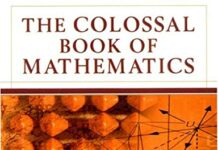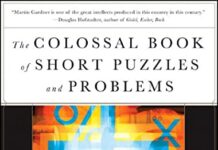
Ebook Info
- Published: 1986
- Number of pages: 144 pages
- Format: PDF
- File Size: 2.50 MB
- Authors: Martin Gardner
Description
Playing with mathematical riddles can be an intriguing and fun-filled pastime — as popular science writer Martin Gardner proves in this entertaining collection. Puzzlists need only an elementary knowledge of math and a will to resist looking up the answer before trying to solve a problem.Written in a light and witty style, Entertaining Mathematical Puzzles is a mixture of old and new riddles, grouped into sections that cover a variety of mathematical topics: money, speed, plane and solid geometry, probability, topology, tricky puzzles, and more. The probability section, for example, points out that everything we do, everything that happens around us, obeys the laws of probability; geometry puzzles test our ability to think pictorially and often, in more than one dimension; while topology, among the “youngest and rowdiest branches of modern geometry,” offers a glimpse into a strange dimension where properties remain unchanged, no matter how a figure is twisted, stretched, or compressed.Clear and concise comments at the beginning of each section explain the nature and importance of the math needed to solve each puzzle. A carefully explained solution follows each problem. In many cases, all that is needed to solve a puzzle is the ability to think logically and clearly, to be “on the alert for surprising, off-beat angles…that strange hidden factor that everyone else had overlooked.”Fully illustrated, this engaging collection will appeal to parents and children, amateur mathematicians, scientists, and students alike, and may, as the author writes, make the reader “want to study the subject in earnest” and explains “some of the inviting paths that wind away from the problems into lusher areas of the mathematical jungle.” 65 black-and-white illustrations.
User’s Reviews
Editorial Reviews: From the Back Cover Playing with mathematical riddles can be an intriguing and fun-filled pastime — as popular science writer Martin Gardner proves in this entertaining collection. Puzzlists need only an elementary knowledge of math and a will to resist looking up the answer before trying to solve a problem. Written in a light and witty style, Entertaining Mathematical Puzzles is a mixture of old and new riddles, grouped into sections that cover a variety of mathematical topics: money, speed, plane and solid geometry, probability, topology, tricky puzzles, and more. The probability section, for example, points out that everything we do, everything that happens around us, obeys the laws of probability; geometry puzzles test our ability to think pictorially and often, in more than one dimension; while topology, among the “youngest and rowdiest branches of modern geometry,” offers a glimpse into a strange dimension where properties remain unchanged, no matter how a figure is twisted, stretched, or compressed. Clear and concise comments at the beginning of each section explain the nature and importance of the math needed to solve each puzzle. A carefully explained solution follows each problem. In many cases, all that is needed to solve a puzzle is the ability to think logically and clearly, to be “on the alert for surprising, off-beat angles…that strange hidden factor that everyone else had overlooked.” Fully illustrated, this engaging collection will appeal to parents and children, amateur mathematicians, scientists, and students alike, and may, as the author writes, make the reader “want to study the subject in earnest” and explains “some of the inviting paths that wind away from the problems into lusher areas of the mathematical jungle.” 65 black-and-white illustrations. About the Author Martin Gardner was a renowned author who published over 70 books on subjects from science and math to poetry and religion. He also had a lifelong passion for magic tricks and puzzles. Well known for his mathematical games column in Scientific American and his “Trick of the Month” in Physics Teacher magazine, Gardner attracted a loyal following with his intelligence, wit, and imagination.Martin Gardner: A Remembrance The worldwide mathematical community was saddened by the death of Martin Gardner on May 22, 2010. Martin was 95 years old when he died, and had written 70 or 80 books during his long lifetime as an author. Martin’s first Dover books were published in 1956 and 1957: Mathematics, Magic and Mystery, one of the first popular books on the intellectual excitement of mathematics to reach a wide audience, and Fads and Fallacies in the Name of Science, certainly one of the first popular books to cast a devastatingly skeptical eye on the claims of pseudoscience and the many guises in which the modern world has given rise to it. Both of these pioneering books are still in print with Dover today along with more than a dozen other titles of Martin’s books. They run the gamut from his elementary Codes, Ciphers and Secret Writing, which has been enjoyed by generations of younger readers since the 1980s, to the more demanding The New Ambidextrous Universe: Symmetry and Asymmetry from Mirror Reflections to Superstrings, which Dover published in its final revised form in 2005. To those of us who have been associated with Dover for a long time, however, Martin was more than an author, albeit a remarkably popular and successful one. As a member of the small group of long-time advisors and consultants, which included NYU’s Morris Kline in mathematics, Harvard’s I. Bernard Cohen in the history of science, and MIT’s J. P. Den Hartog in engineering, Martin’s advice and editorial suggestions in the formative 1950s helped to define the Dover publishing program and give it the point of view which — despite many changes, new directions, and the consequences of evolution — continues to be operative today. In the Author’s Own Words:”Politicians, real-estate agents, used-car salesmen, and advertising copy-writers are expected to stretch facts in self-serving directions, but scientists who falsify their results are regarded by their peers as committing an inexcusable crime. Yet the sad fact is that the history of science swarms with cases of outright fakery and instances of scientists who unconsciously distorted their work by seeing it through lenses of passionately held beliefs.” “A surprising proportion of mathematicians are accomplished musicians. Is it because music and mathematics share patterns that are beautiful?” — Martin Gardner
Reviews from Amazon users which were colected at the time this book was published on the website:
⭐Enjoyed right up to page 24. On page 24 he has a puzzle regarding which salary offer would you take. In the puzzle, you are given a choice between two salaries, one starting at $4K and another starting at $2K. But in the solution given, he starts both salaries at $4K. Just a typo I am sure, but not sure which is the error and which is correct.
⭐Got this for my boyfriend and I at his request after he heard about Martin Gardner on a radio show. Turned out to be big fun for my dad and my young nephews as well. 3 generations! I do wish that the answers were separate from the puzzle because it’s way too easy to cheat, but of course you can workaround that. Some of the puzzles are huge mind-benders and will leave you scratching your head. Others are more light and fun, but all in all there’s something for everyone here.
⭐Most puzzles are intuitive and simple (which is encouraging).Some problems may simple but without logical thinking, it can be tough.So overall good puzzle book to hone your logic and analytic skill.
⭐This book introduces mathematical puzzles in very respectable way. Though the puzzles are really mathematical puzzles and the attached solutions explain the essential concepts, you don’t need to know lots of knowledge to solve them.However, if you have already read other Martin Gardner’s book or mathematical puzzle books, I do not recommend this book. These puzzles are very common and easy kind of ones.
⭐I’m not done with these puzzles. Some have been entertaining others have been very difficult and frustrating. Either way I’m learning quite a bit by doing these puzzles.
⭐Great product!
⭐Although every puzzle in the book isn’t to my liking, the contents are generally pretty good. It offers a good variety of puzzles that are, indeed, both entertaining and mathematical.
⭐I enjoy math puzzles so was excited to have a variety of puzzles to work on. The puzzles are on various concepts in mathematics and helped me understand concepts and applications in each area.The formatting is strange–it’s an older book which is probably part of it. The answers are right next to the puzzles so it’s hard not to see the answer before working the puzzle. I would much rather have answers at the end–or at least have a page break between the problems and answers.
⭐Not entirely a hit with my maths loving grandson aged ten. He found the puzzles went over his head. This is not necessarily the book’s fault!
⭐Great Fun Book
⭐good. thanks.
⭐I’ve always been a big fan of Gardner’s work, and this one is replacing a tatty copy. Great.
⭐Good
Keywords
Free Download Entertaining Mathematical Puzzles in PDF format
Entertaining Mathematical Puzzles PDF Free Download
Download Entertaining Mathematical Puzzles 1986 PDF Free
Entertaining Mathematical Puzzles 1986 PDF Free Download
Download Entertaining Mathematical Puzzles PDF
Free Download Ebook Entertaining Mathematical Puzzles

